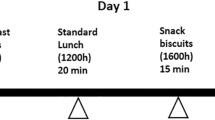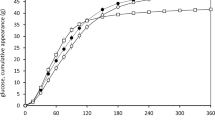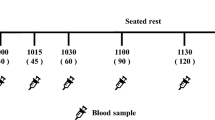Abstract
Objective: To determine the glycaemic index of one variety of date, alone and in mixed meals with plain full-milk yoghurt.
Design: An experimental study involving the measurement of the glycaemic responses of participants to the ingestion of dates, alone and with yoghurt
Setting: Within the Department of Family Medicine, Faculty of Medicine and Health Sciences, UAE University
Subjects: Healthy male and female volunteers aged 32–67 y.
Interventions: Glycaemic responses to date and date/yoghurt meal ingestion were plotted for each subject. Glycaemic indexes were calculated as the ratios of the incremental areas under these response curves to those for glucose ingestion. Results are presented using means and standard deviations. Glycaemic indexes were compared using paired t-tests.
Results: Mean glycaemic indexes of the dates were 47.2, 45.3, 35.5, 37.3, 28.9 for rutab, traditionally stored, commercial, rutab/yoghurt and commercial tamer/yoghurt preparations, respectively. There was a significant difference between the results for rutab vs commercial tamer dates (P<0.05), but other comparisons failed to reach statistical significance.
Conclusions: Khalas dates, when eaten alone or in mixed meals with plain yoghurt have low glycaemic indexes. The consumption of dates may be of benefit in glycaemic and lipid control of diabetic patients. The consumption of dates in mixed meals with yoghurt appears to have, at most, a minimal effect on the glycaemic index.
Sponsorship: This study was not financed by any grant or institution.
This is a preview of subscription content, access via your institution
Access options
Subscribe to this journal
Receive 12 print issues and online access
$259.00 per year
only $21.58 per issue
Buy this article
- Purchase on Springer Link
- Instant access to full article PDF
Prices may be subject to local taxes which are calculated during checkout
Similar content being viewed by others
References
Abdella, NA, Khogali, MM, Salman, AD, Ghuneimi, SA & Bajaj, JS (1995). Pattern of non-insulin dependent diabetes mellitus in Kuwait. Diabetes Res. Clin. Pract., 29, 129–136.
Ahmed, IA, Ahmed, AWK & Robinson, RK (1995). Chemical composition of date varieties as influenced by the stage of ripening. Food Chem., 54, 305–309.
Al Mahroos, F & McKeigue, PM (1998). High prevalence of diabetes in Bahrainis. Associations with ethnicity and raised plasma cholesterol. Diabetes Care, 21, 936–942.
Ali, AY (English translator) (1992). The Meaning of the Holy Qur’an (Koran), chapter 19, verse 25 Brentwood: Amana Corporation
Al Nuaim, AR (1997). Prevalence of glucose intolerance in urban and rural communities in Saudi Arabia. Diabet. Med., 14, 595–602.
Association of Official Analytical Chemists (1990). Official Methods of Analysis, 15th edn Washington, DC: Association of Official Analytical Chemists
Brand, JC, Colagiuri, S, Crossman, S, Allen, A, Roberts, DC & Truswell, AS (1991). Low-glycemic index foods improve long-term glycemic control in NIDDM. Diabetes Care, 14, 95–101.
Brand Miller, JC (1994). Importance of glycemic index in diabetes. Am. J. Clin. Nutr., 59, 747S–752S.
Bukhari, S (2001a). Hadith Vol 3, book 34, verse 411. Available from: http://bismilah.com
Bukhari, S (2001b). Hadith Vol 7, book 65, verse 356. Available from: http://bismilah.com
Buyken, AE, Toeller, M, Heitkamp, G, Karamanos, B, Rottiers, R, Muggeo, M & Fuller, JH (2001). Glycemic index in the diet of European outpatients with type 1 diabetes: relations to glycated hemoglobin and serum lipids. Am. J. Clin. Nutr., 73, 574–581.
El Mugamer, IT, Ali Zayat, AS, Hossain, MM & Pugh, RN (1995). Diabetes, obesity and hypertension in urban and rural people of bedouin origin in the United Arab Emirates. J. Trop. Med. Hyg., 98, 407–415.
Fontvieille, AM, Rizkalla, SW, Penfornis, A, Acosta, M, Bornet, FR & Slama, G (1992). The use of low glycaemic index foods improves metabolic control of diabetic patients over five weeks. Diabet. Med., 9, 444–450.
Ford, ES & Liu, S (2001). Glycemic index and serum high-density lipoprotein cholesterol concentration among US adults. Arch. Intern. Med., 161, 572–576.
Foster-Powell, K & Miller, JB (1995). International tables of glycemic index. Am. J. Clin. Nutr., 62, 871S–890S.
Frost, G, Leeds, AA, Dore, CJ, Madeiros, S, Brading, S & Dornhorst, A (1999). Glycaemic index as a determinant of serum HDL-cholesterol concentration. Lancet, 353, 1045–1048.
Gilbertson, HR, Brand Miller, JC, Thorburn, AW, Evans, S, Chondros, P & Werther, GA (2001). The effect of flexible low glycemic index dietary advice versus measured carbohydrate exchange diets on glycemic control in children with type 1 diabetes. Diabetes Care, 24, 1137–1143.
Gulliford, MC, Bicknell, EJ & Scarpello, JH (1989). Differential effect of protein and fat ingestion on blood glucose responses to high- and low-glycemic-index carbohydrates in noninsulin-dependent diabetic subjects. Am. J. Clin. Nutr., 50, 773–777.
Jenkins, DJ, Wolever, TM, Taylor, RH, Barker, H, Fielden, H, Baldwin, JM, Bowling, AC, Newman, HC, Jenkins, AL & Goff, DV (1981). Glycemic index of foods: a physiological basis for carbohydrate exchange. Am. J. Clin. Nutr., 34, 362–366.
King, H & Rewers, M (1993). Global estimates for prevalence of diabetes mellitus and impaired glucose tolerance in adults. WHO Ad Hoc Diabetes Reporting Group. Diabetes Care, 16, 157–177.
Krueger, RR (1998). Date palm germplasm: overview and utilization in the USA. In: Proceedings of the First International Conference on Date Palms, pp2–37, Al Ain: UAE University
Lock, DR, Bar-Eyal, A, Voet, H & Madar, Z (1988). Glycemic indices of various foods given to pregnant diabetic subjects. Obstet. Gynecol., 71, 180–183.
Pugh, RN, Hossain, MM, Malik, M, El Mugamer, IT & White, MA (1998). Arabian Peninsula men tend to insulin resistance and cardiovascular risk seen in South Asians. Trop. Med. Int. Health, 3, 89–94.
Wolever, TM & Bolognesi, C (1996). Prediction of glucose and insulin responses of normal subjects after consuming mixed meals varying in energy, protein, fat, carbohydrate and glycemic index. J. Nutr., 126, 2807–2812.
Wolever, TM, Jenkins, DJ, Jenkins, AL & Josse, RG (1991). The glycemic index: methodology and clinical implications. Am. J. Clin. Nutr., 54, 846–854.
Wolever, TM, Jenkins, DJ, Vuksan, V, Jenkins, AL, Buckley, GC, Wong, GS & Josse, RG (1992). Beneficial effect of a low glycaemic index diet in type 2 diabetes. Diabetes. Med., 9, 451–458.
Acknowledgements
Professor T Wolever, University of Toronto, is thanked for the Excel glycaemic index calculator, Al Ain date factory for the donation of the dates, Modern Pharmaceutical Company for the donation of glucose testing strips, Central Laboratories Unit, UAE University and Food Environment Control Centre, Abu Dhabi Municipality for analyses of the dates and yoghurt, John Cherian, the technician, who performed the capillary blood tests on the subjects, and, most importantly, the subjects themselves who endured numerous fasts and blood glucose tests.
Author information
Authors and Affiliations
Contributions
Guarantor: CJ Miller.
Contributors: CJ Miller led the research project and was involved in all aspects from conception to writing the article. EVD was involved in study design, data analysis, and writing of the article. IBH coordinated all laboratory analysis and was involved in finalizing the writing of the article.
Corresponding author
Rights and permissions
About this article
Cite this article
Miller, C., Dunn, E. & Hashim, I. The glycaemic index of dates and date/yoghurt mixed meals. Are dates ‘the candy that grows on trees’?. Eur J Clin Nutr 57, 427–430 (2003). https://doi.org/10.1038/sj.ejcn.1601565
Received:
Revised:
Accepted:
Published:
Issue Date:
DOI: https://doi.org/10.1038/sj.ejcn.1601565
Keywords
This article is cited by
-
A glycaemic index compendium of non-western foods
Nutrition & Diabetes (2021)
-
Development of bacoside enriched date syrup juice and its evaluation for physical endurance
Journal of Food Science and Technology (2014)
-
Antioxidant-rich date palm fruit extract inhibits oxidative stress and nephrotoxicity induced by dimethoate in rat
Journal of Physiology and Biochemistry (2012)
-
Glycemic indices of five varieties of dates in healthy and diabetic subjects
Nutrition Journal (2011)



